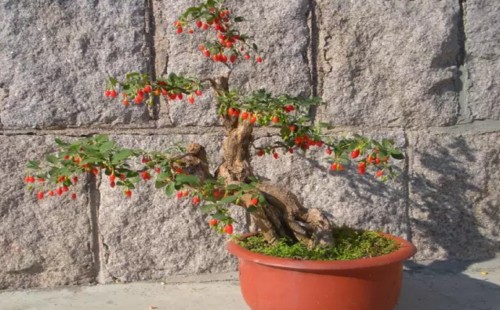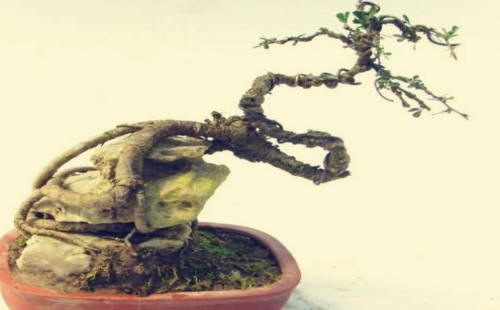The modeling of canary bonsai
The golden finch is also known as the golden finch because its flower shape is very similar to that of the bird spreading its wings and flying high. Broom is not only magical in shape, but also bright in color, so it has high ornamental value. As a result, the canary has become a rare bonsai tree species. And the branches of the canary are soft, resilient, easy to twist, but also resistant to pruning, strong germination and rapid growth, so people like to create various shapes of bonsai for appreciation. So, how to shape the canary bonsai?

Because the roots of the canary are strong, the trunks are straight, and the branches are flexible, there are many shapes that can be made. Whether it is cliff type, jungle type, or lift root type, connected root type, or even stone-attached type, qu Gan type and so on, it is the scope of its modeling application, which can be made into various forms of ornamental bonsai. However, whether it is digging piles or buying piles from the flower market, it is generally necessary to prune and trim the roots in advance according to its tree shape and shape before putting it on the pot. It is mainly to cut off the branches that are not conducive to modeling and the old, weak and residual roots, which can not only promote the rapid germination after the basin, but also facilitate the modeling.
But before making it into a bonsai in the real sense, we also need to transplant it into the viewing basin, so the original experience is a pile-raising process. During this period, you need to go through the process of modeling and shaping roots, and generally raise piles for 1-2 years and then go to the ornamental basin. And the focus of its modeling often needs to be carried out after surviving in the viewing basin. Next, the editor will share with you the modeling skills of the canary in the viewing basin.
Because the canary is resistant to pruning, strong germination ability, flexible branches and various modeling techniques, the modeling of bonsai should vary from material to material, and pruning, flat binding and other means should be used. Generally, when it germinates in the spring of the following year, we need to prune it for the first time, mainly to cut off the useless redundant branches in the molding process, and at the same time, some branches which are not in the right direction but must be retained need to be banded to determine their new growth direction. In addition, attention should be paid to the cultivation of transitional branches to make the growth ratio of branches and stems appear to be more coordinated, and the axillary buds germinated from the roots should be erased in time to save nutrients and ensure that the growing branches have enough nutrients to maintain rapid growth.
By the third year, the broom tree has basically taken shape, and we can choose a suitable weather in spring to transplant the tree to a more ornamental purple sand basin. After taking the basin, we should strengthen the maintenance and management, promote the bonsai to maintain a good growth, and lay a good foundation for a more detailed shaping process in the later stage. I remember that before sprouting in spring every year, the plant should be re-cut, mainly to cut off weak branches, long branches, dry and withered branches and other branches that grow but affect their appearance.
It should be noted that the canary bonsai generally needs to be changed every 2-3 years, and should be carried out in early spring. When changing the basin, half of the old basin soil can be removed and the roots can be trimmed properly, mainly to shorten the overgrown roots, cut off all the old, weak, sick and disabled roots, and take this opportunity to lift the roots of the bonsai so that the roots also have an ornamental modeling effect. However, the broom bonsai is generally dominated by viewing flowers, so timely pruning and shaping is of great significance to improve the overall appreciation of bonsai, especially to promote flowering.
The canary is resistant to pruning and its branches are flexible, so it is relatively easy to achieve modeling by means of pruning, bending, flat binding and so on, and its root system is also very developed, which is convenient for root shaping. We can make different shapes and styles of tree bonsai according to the advantages of the canary and according to our personal preferences. In the specific modeling process, we can use folding, binding, climbing, binding and other means to stabilize the bending of the curved branches, and at the same time can shake and twist properly, so that the branches gradually bend slowly, and finally achieve the effect of bending modeling. But the strength and brute force can not be used in the bending process, mainly to prevent the branches from being broken; and for the sharp bending part, it can be bent several times to gradually meet the modeling needs.
Time: 2019-06-06 Click:
- Prev

When and how to pick the leaves of Chinese wolfberry bonsai
The leaf picking treatment of bonsai trees is an important means to promote the germination of tree species with less times of sprouting and leafing in a year, which can make bonsai trees often keep fresh green leaves, thus full of vitality, and the ornamental value of bonsai is higher. The same is true of Chinese wolfberry bonsai, which is often taken to pick leaves to promote germination.
- Next

How do canary bonsai take root?
Root is an important means to shape the root in the process of making open-root bonsai. First of all, the root should be properly treated in the process of potting, and the soil can not be covered according to the traditional method. When you put it on the basin, you can lift its root slightly and expose it on the soil surface, so that it is not only easier to shape.
Related
- Fuxing push coffee new agricultural production and marketing class: lack of small-scale processing plants
- Jujube rice field leisure farm deep ploughing Yilan for five years to create a space for organic food and play
- Nongyu Farm-A trial of organic papaya for brave women with advanced technology
- Four points for attention in the prevention and control of diseases and insect pests of edible fungi
- How to add nutrient solution to Edible Fungi
- Is there any good way to control edible fungus mites?
- Open Inoculation Technology of Edible Fungi
- Is there any clever way to use fertilizer for edible fungus in winter?
- What agents are used to kill the pathogens of edible fungi in the mushroom shed?
- Rapid drying of Edible Fungi

